The Evolution of Quadrupedalism to Bipedalism
VerifiedAdded on 2023/05/30
|8
|2117
|183
AI Summary
This essay discusses the anatomical changes required for humans to transform from quadrupedalism to bipedalism, along with the behavioral changes that may accompany the physical changes. It also explores the reasons for hominid ancestors to adapt to bipedalism.
Contribute Materials
Your contribution can guide someone’s learning journey. Share your
documents today.

Running head: THE EVOLUTION OF QUADRUPEDALISM TO BIPEDALISM
THE EVOLUTION OF QUADRUPEDALISM TO BIPEDALISM
Name of the student:
Name of the university:
Author note:
THE EVOLUTION OF QUADRUPEDALISM TO BIPEDALISM
Name of the student:
Name of the university:
Author note:
Secure Best Marks with AI Grader
Need help grading? Try our AI Grader for instant feedback on your assignments.
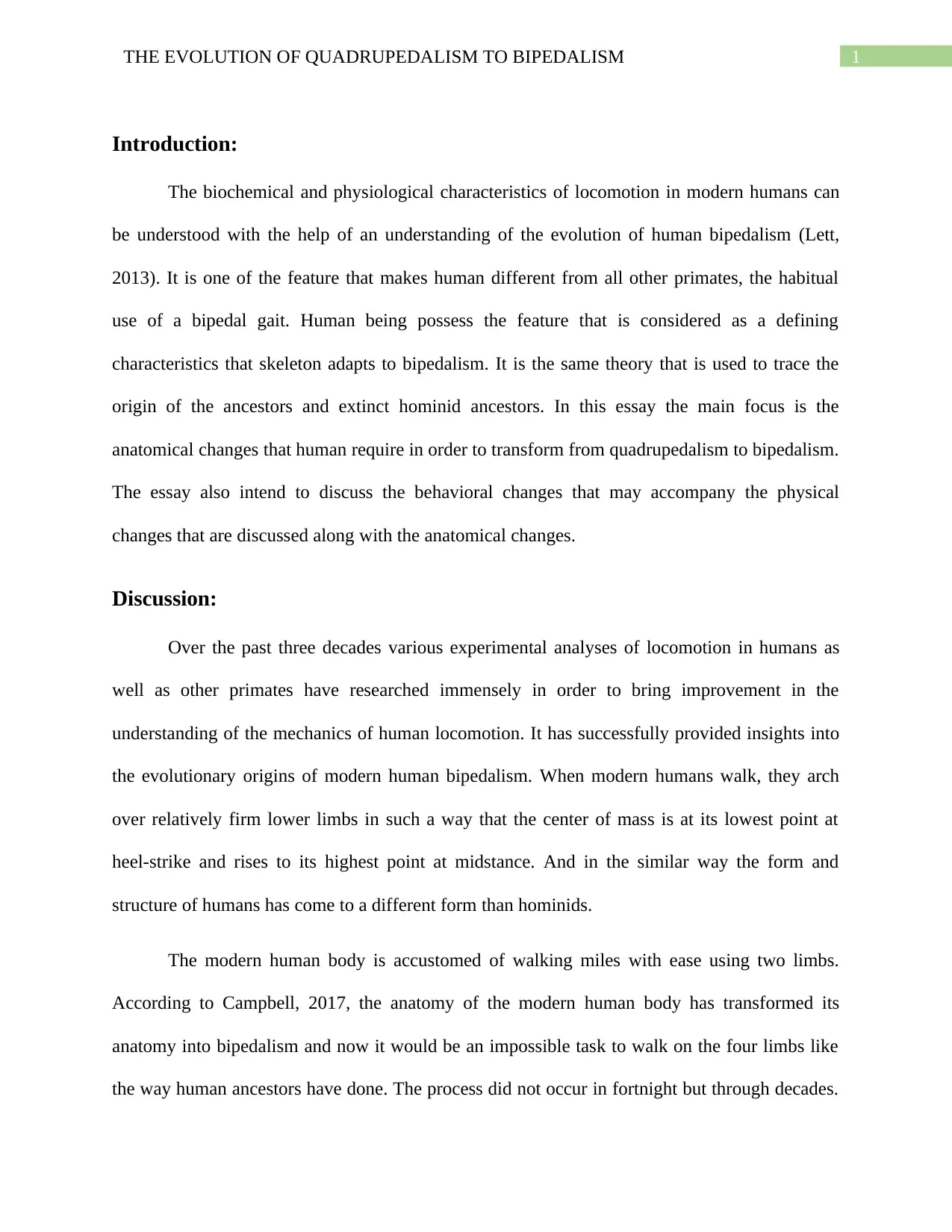
1THE EVOLUTION OF QUADRUPEDALISM TO BIPEDALISM
Introduction:
The biochemical and physiological characteristics of locomotion in modern humans can
be understood with the help of an understanding of the evolution of human bipedalism (Lett,
2013). It is one of the feature that makes human different from all other primates, the habitual
use of a bipedal gait. Human being possess the feature that is considered as a defining
characteristics that skeleton adapts to bipedalism. It is the same theory that is used to trace the
origin of the ancestors and extinct hominid ancestors. In this essay the main focus is the
anatomical changes that human require in order to transform from quadrupedalism to bipedalism.
The essay also intend to discuss the behavioral changes that may accompany the physical
changes that are discussed along with the anatomical changes.
Discussion:
Over the past three decades various experimental analyses of locomotion in humans as
well as other primates have researched immensely in order to bring improvement in the
understanding of the mechanics of human locomotion. It has successfully provided insights into
the evolutionary origins of modern human bipedalism. When modern humans walk, they arch
over relatively firm lower limbs in such a way that the center of mass is at its lowest point at
heel-strike and rises to its highest point at midstance. And in the similar way the form and
structure of humans has come to a different form than hominids.
The modern human body is accustomed of walking miles with ease using two limbs.
According to Campbell, 2017, the anatomy of the modern human body has transformed its
anatomy into bipedalism and now it would be an impossible task to walk on the four limbs like
the way human ancestors have done. The process did not occur in fortnight but through decades.
Introduction:
The biochemical and physiological characteristics of locomotion in modern humans can
be understood with the help of an understanding of the evolution of human bipedalism (Lett,
2013). It is one of the feature that makes human different from all other primates, the habitual
use of a bipedal gait. Human being possess the feature that is considered as a defining
characteristics that skeleton adapts to bipedalism. It is the same theory that is used to trace the
origin of the ancestors and extinct hominid ancestors. In this essay the main focus is the
anatomical changes that human require in order to transform from quadrupedalism to bipedalism.
The essay also intend to discuss the behavioral changes that may accompany the physical
changes that are discussed along with the anatomical changes.
Discussion:
Over the past three decades various experimental analyses of locomotion in humans as
well as other primates have researched immensely in order to bring improvement in the
understanding of the mechanics of human locomotion. It has successfully provided insights into
the evolutionary origins of modern human bipedalism. When modern humans walk, they arch
over relatively firm lower limbs in such a way that the center of mass is at its lowest point at
heel-strike and rises to its highest point at midstance. And in the similar way the form and
structure of humans has come to a different form than hominids.
The modern human body is accustomed of walking miles with ease using two limbs.
According to Campbell, 2017, the anatomy of the modern human body has transformed its
anatomy into bipedalism and now it would be an impossible task to walk on the four limbs like
the way human ancestors have done. The process did not occur in fortnight but through decades.
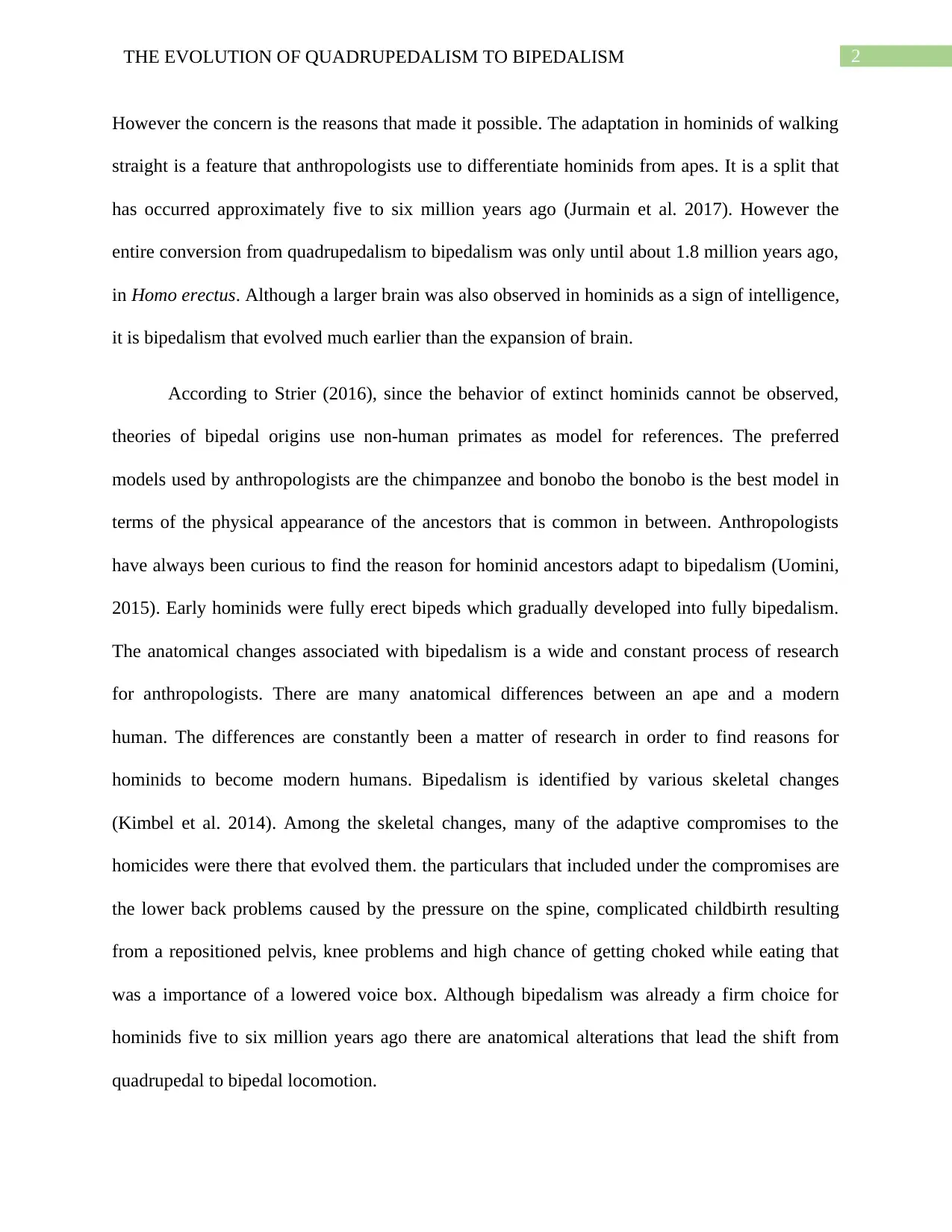
2THE EVOLUTION OF QUADRUPEDALISM TO BIPEDALISM
However the concern is the reasons that made it possible. The adaptation in hominids of walking
straight is a feature that anthropologists use to differentiate hominids from apes. It is a split that
has occurred approximately five to six million years ago (Jurmain et al. 2017). However the
entire conversion from quadrupedalism to bipedalism was only until about 1.8 million years ago,
in Homo erectus. Although a larger brain was also observed in hominids as a sign of intelligence,
it is bipedalism that evolved much earlier than the expansion of brain.
According to Strier (2016), since the behavior of extinct hominids cannot be observed,
theories of bipedal origins use non-human primates as model for references. The preferred
models used by anthropologists are the chimpanzee and bonobo the bonobo is the best model in
terms of the physical appearance of the ancestors that is common in between. Anthropologists
have always been curious to find the reason for hominid ancestors adapt to bipedalism (Uomini,
2015). Early hominids were fully erect bipeds which gradually developed into fully bipedalism.
The anatomical changes associated with bipedalism is a wide and constant process of research
for anthropologists. There are many anatomical differences between an ape and a modern
human. The differences are constantly been a matter of research in order to find reasons for
hominids to become modern humans. Bipedalism is identified by various skeletal changes
(Kimbel et al. 2014). Among the skeletal changes, many of the adaptive compromises to the
homicides were there that evolved them. the particulars that included under the compromises are
the lower back problems caused by the pressure on the spine, complicated childbirth resulting
from a repositioned pelvis, knee problems and high chance of getting choked while eating that
was a importance of a lowered voice box. Although bipedalism was already a firm choice for
hominids five to six million years ago there are anatomical alterations that lead the shift from
quadrupedal to bipedal locomotion.
However the concern is the reasons that made it possible. The adaptation in hominids of walking
straight is a feature that anthropologists use to differentiate hominids from apes. It is a split that
has occurred approximately five to six million years ago (Jurmain et al. 2017). However the
entire conversion from quadrupedalism to bipedalism was only until about 1.8 million years ago,
in Homo erectus. Although a larger brain was also observed in hominids as a sign of intelligence,
it is bipedalism that evolved much earlier than the expansion of brain.
According to Strier (2016), since the behavior of extinct hominids cannot be observed,
theories of bipedal origins use non-human primates as model for references. The preferred
models used by anthropologists are the chimpanzee and bonobo the bonobo is the best model in
terms of the physical appearance of the ancestors that is common in between. Anthropologists
have always been curious to find the reason for hominid ancestors adapt to bipedalism (Uomini,
2015). Early hominids were fully erect bipeds which gradually developed into fully bipedalism.
The anatomical changes associated with bipedalism is a wide and constant process of research
for anthropologists. There are many anatomical differences between an ape and a modern
human. The differences are constantly been a matter of research in order to find reasons for
hominids to become modern humans. Bipedalism is identified by various skeletal changes
(Kimbel et al. 2014). Among the skeletal changes, many of the adaptive compromises to the
homicides were there that evolved them. the particulars that included under the compromises are
the lower back problems caused by the pressure on the spine, complicated childbirth resulting
from a repositioned pelvis, knee problems and high chance of getting choked while eating that
was a importance of a lowered voice box. Although bipedalism was already a firm choice for
hominids five to six million years ago there are anatomical alterations that lead the shift from
quadrupedal to bipedal locomotion.
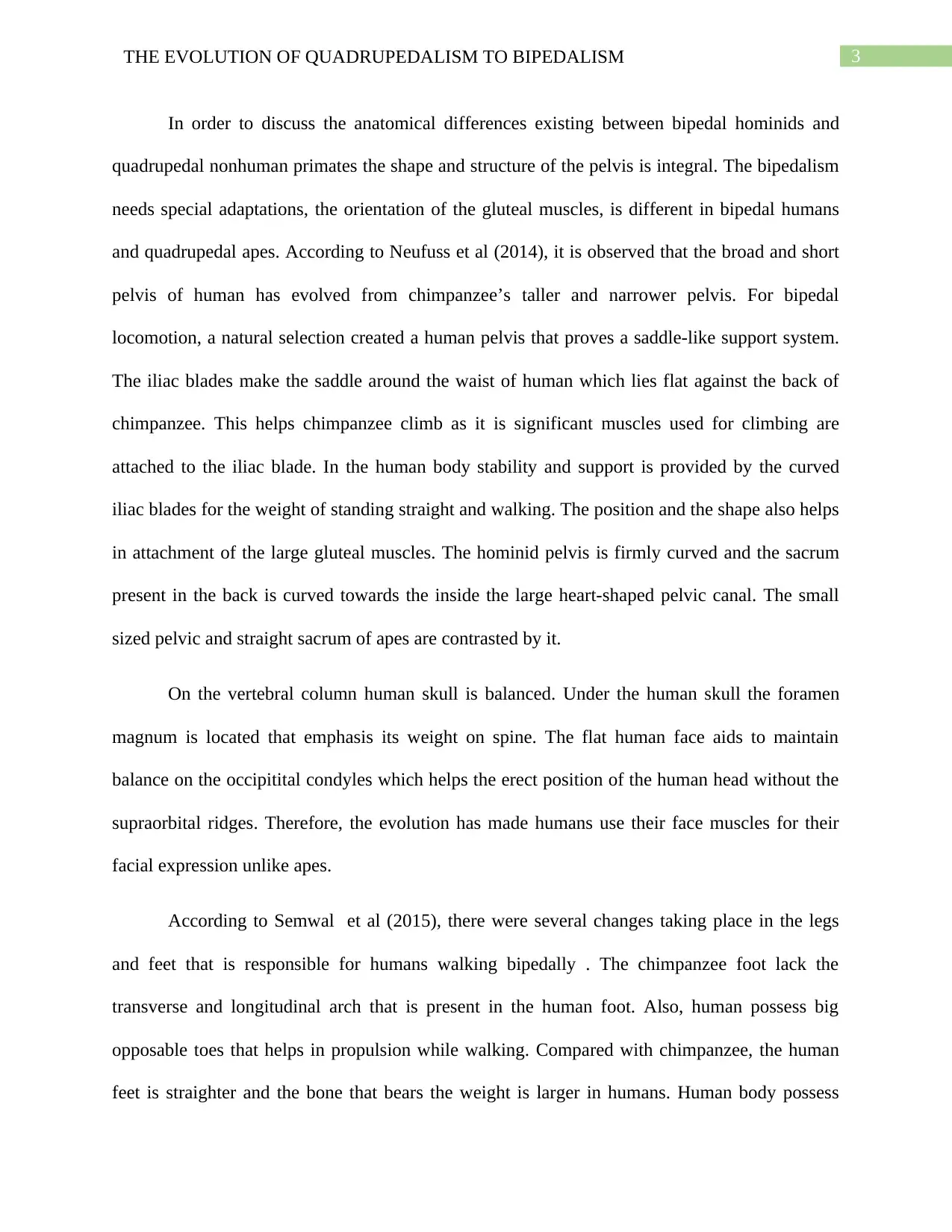
3THE EVOLUTION OF QUADRUPEDALISM TO BIPEDALISM
In order to discuss the anatomical differences existing between bipedal hominids and
quadrupedal nonhuman primates the shape and structure of the pelvis is integral. The bipedalism
needs special adaptations, the orientation of the gluteal muscles, is different in bipedal humans
and quadrupedal apes. According to Neufuss et al (2014), it is observed that the broad and short
pelvis of human has evolved from chimpanzee’s taller and narrower pelvis. For bipedal
locomotion, a natural selection created a human pelvis that proves a saddle-like support system.
The iliac blades make the saddle around the waist of human which lies flat against the back of
chimpanzee. This helps chimpanzee climb as it is significant muscles used for climbing are
attached to the iliac blade. In the human body stability and support is provided by the curved
iliac blades for the weight of standing straight and walking. The position and the shape also helps
in attachment of the large gluteal muscles. The hominid pelvis is firmly curved and the sacrum
present in the back is curved towards the inside the large heart-shaped pelvic canal. The small
sized pelvic and straight sacrum of apes are contrasted by it.
On the vertebral column human skull is balanced. Under the human skull the foramen
magnum is located that emphasis its weight on spine. The flat human face aids to maintain
balance on the occipitital condyles which helps the erect position of the human head without the
supraorbital ridges. Therefore, the evolution has made humans use their face muscles for their
facial expression unlike apes.
According to Semwal et al (2015), there were several changes taking place in the legs
and feet that is responsible for humans walking bipedally . The chimpanzee foot lack the
transverse and longitudinal arch that is present in the human foot. Also, human possess big
opposable toes that helps in propulsion while walking. Compared with chimpanzee, the human
feet is straighter and the bone that bears the weight is larger in humans. Human body possess
In order to discuss the anatomical differences existing between bipedal hominids and
quadrupedal nonhuman primates the shape and structure of the pelvis is integral. The bipedalism
needs special adaptations, the orientation of the gluteal muscles, is different in bipedal humans
and quadrupedal apes. According to Neufuss et al (2014), it is observed that the broad and short
pelvis of human has evolved from chimpanzee’s taller and narrower pelvis. For bipedal
locomotion, a natural selection created a human pelvis that proves a saddle-like support system.
The iliac blades make the saddle around the waist of human which lies flat against the back of
chimpanzee. This helps chimpanzee climb as it is significant muscles used for climbing are
attached to the iliac blade. In the human body stability and support is provided by the curved
iliac blades for the weight of standing straight and walking. The position and the shape also helps
in attachment of the large gluteal muscles. The hominid pelvis is firmly curved and the sacrum
present in the back is curved towards the inside the large heart-shaped pelvic canal. The small
sized pelvic and straight sacrum of apes are contrasted by it.
On the vertebral column human skull is balanced. Under the human skull the foramen
magnum is located that emphasis its weight on spine. The flat human face aids to maintain
balance on the occipitital condyles which helps the erect position of the human head without the
supraorbital ridges. Therefore, the evolution has made humans use their face muscles for their
facial expression unlike apes.
According to Semwal et al (2015), there were several changes taking place in the legs
and feet that is responsible for humans walking bipedally . The chimpanzee foot lack the
transverse and longitudinal arch that is present in the human foot. Also, human possess big
opposable toes that helps in propulsion while walking. Compared with chimpanzee, the human
feet is straighter and the bone that bears the weight is larger in humans. Human body possess
Secure Best Marks with AI Grader
Need help grading? Try our AI Grader for instant feedback on your assignments.
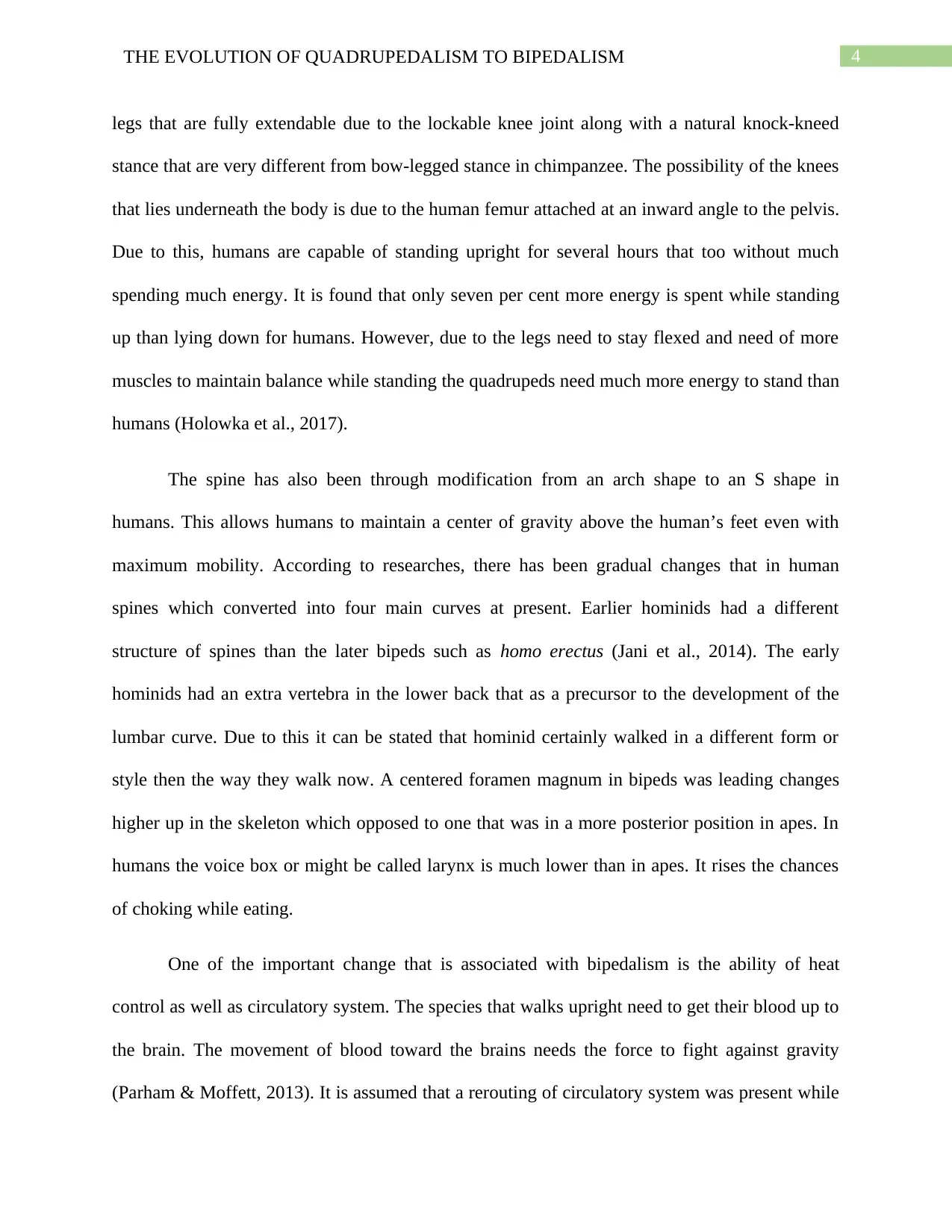
4THE EVOLUTION OF QUADRUPEDALISM TO BIPEDALISM
legs that are fully extendable due to the lockable knee joint along with a natural knock-kneed
stance that are very different from bow-legged stance in chimpanzee. The possibility of the knees
that lies underneath the body is due to the human femur attached at an inward angle to the pelvis.
Due to this, humans are capable of standing upright for several hours that too without much
spending much energy. It is found that only seven per cent more energy is spent while standing
up than lying down for humans. However, due to the legs need to stay flexed and need of more
muscles to maintain balance while standing the quadrupeds need much more energy to stand than
humans (Holowka et al., 2017).
The spine has also been through modification from an arch shape to an S shape in
humans. This allows humans to maintain a center of gravity above the human’s feet even with
maximum mobility. According to researches, there has been gradual changes that in human
spines which converted into four main curves at present. Earlier hominids had a different
structure of spines than the later bipeds such as homo erectus (Jani et al., 2014). The early
hominids had an extra vertebra in the lower back that as a precursor to the development of the
lumbar curve. Due to this it can be stated that hominid certainly walked in a different form or
style then the way they walk now. A centered foramen magnum in bipeds was leading changes
higher up in the skeleton which opposed to one that was in a more posterior position in apes. In
humans the voice box or might be called larynx is much lower than in apes. It rises the chances
of choking while eating.
One of the important change that is associated with bipedalism is the ability of heat
control as well as circulatory system. The species that walks upright need to get their blood up to
the brain. The movement of blood toward the brains needs the force to fight against gravity
(Parham & Moffett, 2013). It is assumed that a rerouting of circulatory system was present while
legs that are fully extendable due to the lockable knee joint along with a natural knock-kneed
stance that are very different from bow-legged stance in chimpanzee. The possibility of the knees
that lies underneath the body is due to the human femur attached at an inward angle to the pelvis.
Due to this, humans are capable of standing upright for several hours that too without much
spending much energy. It is found that only seven per cent more energy is spent while standing
up than lying down for humans. However, due to the legs need to stay flexed and need of more
muscles to maintain balance while standing the quadrupeds need much more energy to stand than
humans (Holowka et al., 2017).
The spine has also been through modification from an arch shape to an S shape in
humans. This allows humans to maintain a center of gravity above the human’s feet even with
maximum mobility. According to researches, there has been gradual changes that in human
spines which converted into four main curves at present. Earlier hominids had a different
structure of spines than the later bipeds such as homo erectus (Jani et al., 2014). The early
hominids had an extra vertebra in the lower back that as a precursor to the development of the
lumbar curve. Due to this it can be stated that hominid certainly walked in a different form or
style then the way they walk now. A centered foramen magnum in bipeds was leading changes
higher up in the skeleton which opposed to one that was in a more posterior position in apes. In
humans the voice box or might be called larynx is much lower than in apes. It rises the chances
of choking while eating.
One of the important change that is associated with bipedalism is the ability of heat
control as well as circulatory system. The species that walks upright need to get their blood up to
the brain. The movement of blood toward the brains needs the force to fight against gravity
(Parham & Moffett, 2013). It is assumed that a rerouting of circulatory system was present while
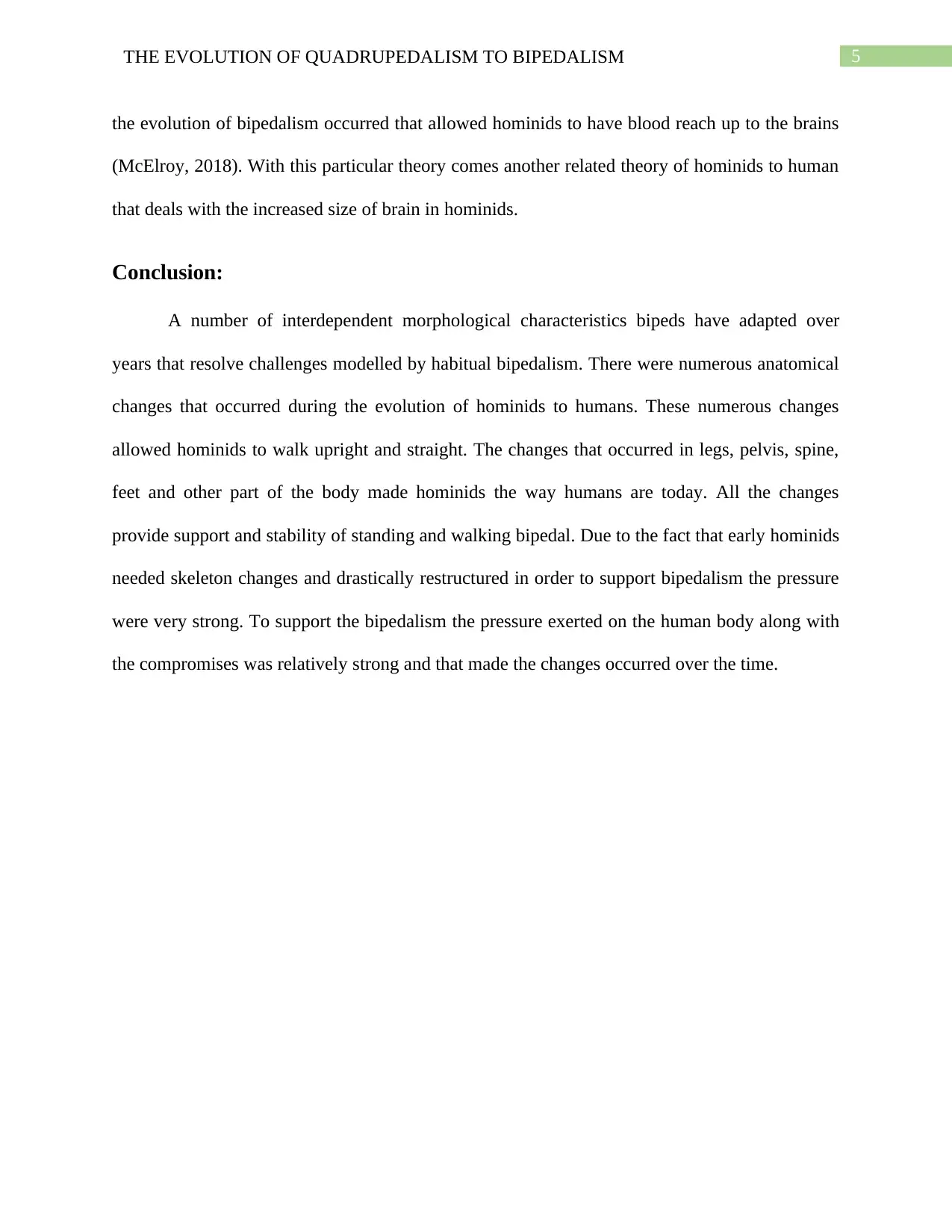
5THE EVOLUTION OF QUADRUPEDALISM TO BIPEDALISM
the evolution of bipedalism occurred that allowed hominids to have blood reach up to the brains
(McElroy, 2018). With this particular theory comes another related theory of hominids to human
that deals with the increased size of brain in hominids.
Conclusion:
A number of interdependent morphological characteristics bipeds have adapted over
years that resolve challenges modelled by habitual bipedalism. There were numerous anatomical
changes that occurred during the evolution of hominids to humans. These numerous changes
allowed hominids to walk upright and straight. The changes that occurred in legs, pelvis, spine,
feet and other part of the body made hominids the way humans are today. All the changes
provide support and stability of standing and walking bipedal. Due to the fact that early hominids
needed skeleton changes and drastically restructured in order to support bipedalism the pressure
were very strong. To support the bipedalism the pressure exerted on the human body along with
the compromises was relatively strong and that made the changes occurred over the time.
the evolution of bipedalism occurred that allowed hominids to have blood reach up to the brains
(McElroy, 2018). With this particular theory comes another related theory of hominids to human
that deals with the increased size of brain in hominids.
Conclusion:
A number of interdependent morphological characteristics bipeds have adapted over
years that resolve challenges modelled by habitual bipedalism. There were numerous anatomical
changes that occurred during the evolution of hominids to humans. These numerous changes
allowed hominids to walk upright and straight. The changes that occurred in legs, pelvis, spine,
feet and other part of the body made hominids the way humans are today. All the changes
provide support and stability of standing and walking bipedal. Due to the fact that early hominids
needed skeleton changes and drastically restructured in order to support bipedalism the pressure
were very strong. To support the bipedalism the pressure exerted on the human body along with
the compromises was relatively strong and that made the changes occurred over the time.
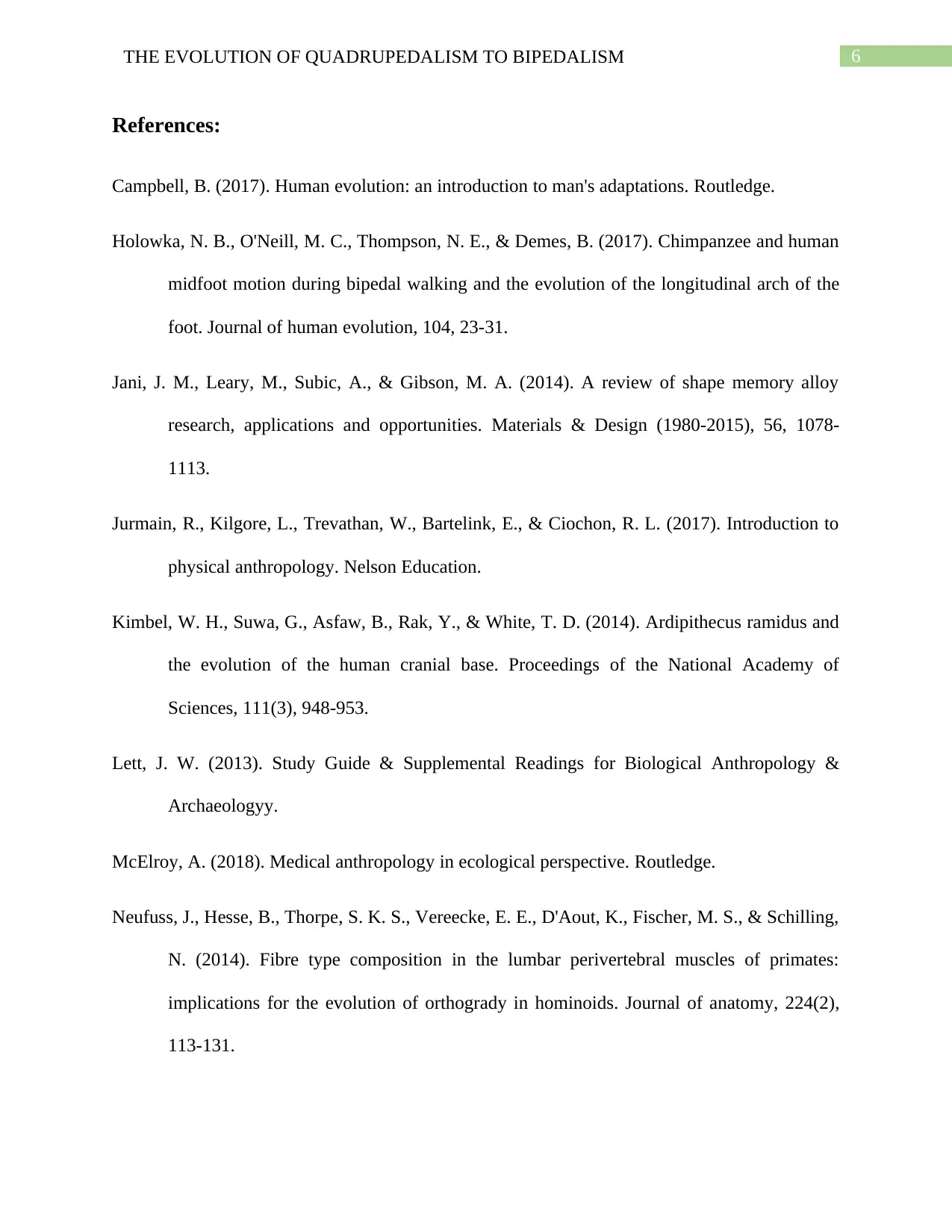
6THE EVOLUTION OF QUADRUPEDALISM TO BIPEDALISM
References:
Campbell, B. (2017). Human evolution: an introduction to man's adaptations. Routledge.
Holowka, N. B., O'Neill, M. C., Thompson, N. E., & Demes, B. (2017). Chimpanzee and human
midfoot motion during bipedal walking and the evolution of the longitudinal arch of the
foot. Journal of human evolution, 104, 23-31.
Jani, J. M., Leary, M., Subic, A., & Gibson, M. A. (2014). A review of shape memory alloy
research, applications and opportunities. Materials & Design (1980-2015), 56, 1078-
1113.
Jurmain, R., Kilgore, L., Trevathan, W., Bartelink, E., & Ciochon, R. L. (2017). Introduction to
physical anthropology. Nelson Education.
Kimbel, W. H., Suwa, G., Asfaw, B., Rak, Y., & White, T. D. (2014). Ardipithecus ramidus and
the evolution of the human cranial base. Proceedings of the National Academy of
Sciences, 111(3), 948-953.
Lett, J. W. (2013). Study Guide & Supplemental Readings for Biological Anthropology &
Archaeologyy.
McElroy, A. (2018). Medical anthropology in ecological perspective. Routledge.
Neufuss, J., Hesse, B., Thorpe, S. K. S., Vereecke, E. E., D'Aout, K., Fischer, M. S., & Schilling,
N. (2014). Fibre type composition in the lumbar perivertebral muscles of primates:
implications for the evolution of orthogrady in hominoids. Journal of anatomy, 224(2),
113-131.
References:
Campbell, B. (2017). Human evolution: an introduction to man's adaptations. Routledge.
Holowka, N. B., O'Neill, M. C., Thompson, N. E., & Demes, B. (2017). Chimpanzee and human
midfoot motion during bipedal walking and the evolution of the longitudinal arch of the
foot. Journal of human evolution, 104, 23-31.
Jani, J. M., Leary, M., Subic, A., & Gibson, M. A. (2014). A review of shape memory alloy
research, applications and opportunities. Materials & Design (1980-2015), 56, 1078-
1113.
Jurmain, R., Kilgore, L., Trevathan, W., Bartelink, E., & Ciochon, R. L. (2017). Introduction to
physical anthropology. Nelson Education.
Kimbel, W. H., Suwa, G., Asfaw, B., Rak, Y., & White, T. D. (2014). Ardipithecus ramidus and
the evolution of the human cranial base. Proceedings of the National Academy of
Sciences, 111(3), 948-953.
Lett, J. W. (2013). Study Guide & Supplemental Readings for Biological Anthropology &
Archaeologyy.
McElroy, A. (2018). Medical anthropology in ecological perspective. Routledge.
Neufuss, J., Hesse, B., Thorpe, S. K. S., Vereecke, E. E., D'Aout, K., Fischer, M. S., & Schilling,
N. (2014). Fibre type composition in the lumbar perivertebral muscles of primates:
implications for the evolution of orthogrady in hominoids. Journal of anatomy, 224(2),
113-131.
Paraphrase This Document
Need a fresh take? Get an instant paraphrase of this document with our AI Paraphraser
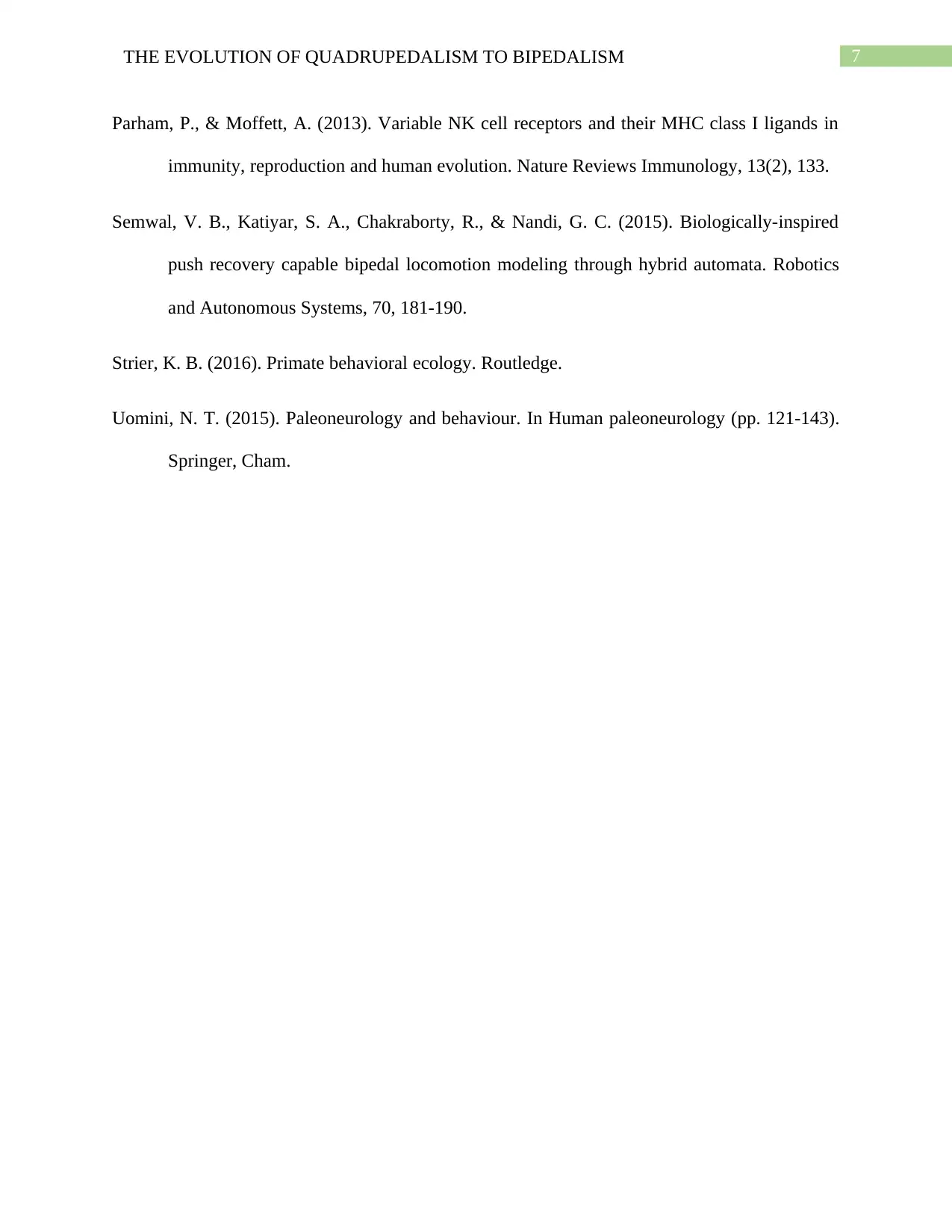
7THE EVOLUTION OF QUADRUPEDALISM TO BIPEDALISM
Parham, P., & Moffett, A. (2013). Variable NK cell receptors and their MHC class I ligands in
immunity, reproduction and human evolution. Nature Reviews Immunology, 13(2), 133.
Semwal, V. B., Katiyar, S. A., Chakraborty, R., & Nandi, G. C. (2015). Biologically-inspired
push recovery capable bipedal locomotion modeling through hybrid automata. Robotics
and Autonomous Systems, 70, 181-190.
Strier, K. B. (2016). Primate behavioral ecology. Routledge.
Uomini, N. T. (2015). Paleoneurology and behaviour. In Human paleoneurology (pp. 121-143).
Springer, Cham.
Parham, P., & Moffett, A. (2013). Variable NK cell receptors and their MHC class I ligands in
immunity, reproduction and human evolution. Nature Reviews Immunology, 13(2), 133.
Semwal, V. B., Katiyar, S. A., Chakraborty, R., & Nandi, G. C. (2015). Biologically-inspired
push recovery capable bipedal locomotion modeling through hybrid automata. Robotics
and Autonomous Systems, 70, 181-190.
Strier, K. B. (2016). Primate behavioral ecology. Routledge.
Uomini, N. T. (2015). Paleoneurology and behaviour. In Human paleoneurology (pp. 121-143).
Springer, Cham.
1 out of 8
Related Documents
Your All-in-One AI-Powered Toolkit for Academic Success.
+13062052269
info@desklib.com
Available 24*7 on WhatsApp / Email
![[object Object]](/_next/static/media/star-bottom.7253800d.svg)
Unlock your academic potential
© 2024 | Zucol Services PVT LTD | All rights reserved.




